
Installation Guide
National Electrical Code Compliance
5
National Electrical Code Compliance
The following information is for general reference and is not intended to replace recommended National
Electric Code (NEC) procedures. It is important for the installer to understand that electrical equipment and
wiring located in Class I, Division 1 and 2 installations shall comply with the latest appropriate articles found in
the National Electric Code (NFPA 70) and the Code for Motor Fuel Dispensing Facilities and Repair Garages
(NFPA 30A), or other local code such as the CEC, Canadian Electrical Code.
TLS RF UNIT-TO-TLS CONSOLE WIRING
Wire Type
To ensure the best operating systems available, Veeder-Root REQUIRES the use of shielded cable for probe
outputs regardless of conduit material or application. In these installations, shielded cable must be rated less
than 100 picofarad per foot and be manufactured with a material suitable for the environment, such as Carol™
C2534 or Belden™ 88760, 8760, or 8770.
Wire Length
Improper system operation could result in undetected potential environmental and health hazards if the TLS
RF-to-TLS Console wire runs exceed 1000 feet. Wire runs must be less than 1000 feet to meet intrinsic
safety requirements.
Splices
Veeder-Root recommends that no splices be made in the wire run between the TLS RF and the TLS Console.
Each splice degrades signal strength and could result in poor system performance.
Wire Gauges - Color coded
Shielded cable must be used in all installations. TLS RF-to-TLS console wires should be #14-#18 AWG
stranded copper wire and installed as a Class 1 circuit. As an alternate method when approved by the local
authority having jurisdiction, 22 AWG wire such as Belden 88761 may be suitable in installations with the
following provisions:
- Wire run is less than 750 feet
- Capacitance does not exceed 100 pF/foot
- Inductance does not exceed 0.2 µH/foot
TLS RF POWER WIRING
Wires carrying 120 or 240 Vac from the power panel to the TLS RF should be #14 AWG copper wire for line,
neutral and chassis ground (3); and #12 AWG copper wire for barrier ground (1).











































